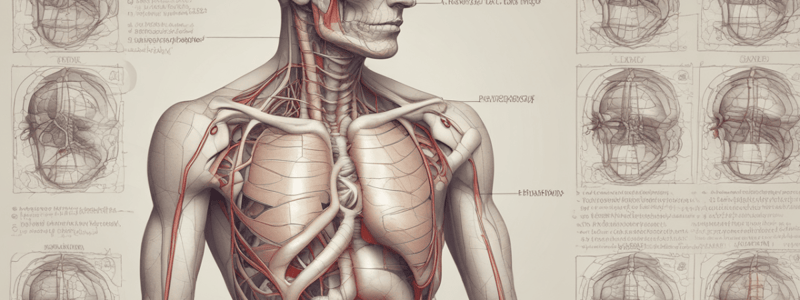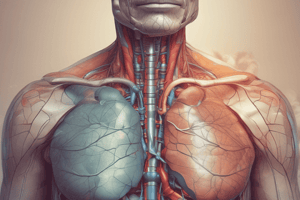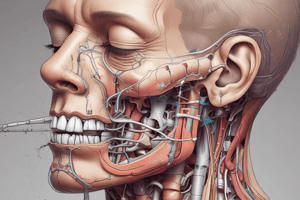Podcast
Questions and Answers
What characterizes a pneumothorax?
What characterizes a pneumothorax?
Which demographic is most at risk for spontaneous pneumothorax?
Which demographic is most at risk for spontaneous pneumothorax?
What is the primary risk factor associated with spontaneous pneumothorax?
What is the primary risk factor associated with spontaneous pneumothorax?
What occurs during a tension pneumothorax?
What occurs during a tension pneumothorax?
Signup and view all the answers
What symptom may indicate a pneumothorax?
What symptom may indicate a pneumothorax?
Signup and view all the answers
What is a management step for someone with a hemothorax?
What is a management step for someone with a hemothorax?
Signup and view all the answers
What causes a mediatinal shift in the context of a tension pneumothorax?
What causes a mediatinal shift in the context of a tension pneumothorax?
Signup and view all the answers
What is a characteristic sign of tension pneumothorax?
What is a characteristic sign of tension pneumothorax?
Signup and view all the answers
Which of the following describes hemopneumothorax?
Which of the following describes hemopneumothorax?
Signup and view all the answers
What is the main difference between a pneumothorax and a hemothorax?
What is the main difference between a pneumothorax and a hemothorax?
Signup and view all the answers
What is a characteristic of a spontaneous pneumothorax?
What is a characteristic of a spontaneous pneumothorax?
Signup and view all the answers
What is a complication of a tension pneumothorax?
What is a complication of a tension pneumothorax?
Signup and view all the answers
What is a key feature of hemopneumothorax?
What is a key feature of hemopneumothorax?
Signup and view all the answers
What is a sign of a tension pneumothorax?
What is a sign of a tension pneumothorax?
Signup and view all the answers
What is a priority in managing a patient with a pneumothorax?
What is a priority in managing a patient with a pneumothorax?
Signup and view all the answers
What type of injury can cause a pneumothorax, hemothorax, or hemopneumothorax?
What type of injury can cause a pneumothorax, hemothorax, or hemopneumothorax?
Signup and view all the answers
What is a common presentation of a patient with a pneumothorax?
What is a common presentation of a patient with a pneumothorax?
Signup and view all the answers
Why is it essential to transport a patient with a pneumothorax quickly?
Why is it essential to transport a patient with a pneumothorax quickly?
Signup and view all the answers
Study Notes
Pneumothorax, Hemothorax, and Hemopneumothorax
- Pneumothorax: air in the plural cavity that doesn't exit, leading to a collapsed lung
- Hemothorax: blood in the plural cavity of the thorax
- Hemopneumothorax: combination of both pneumothorax and hemothorax
Spontaneous Pneumothorax
- Typically occurs in 60-65 year olds
- Caused by rupture of blebs (air-filled cysts) due to increased intrathoracic pressure (sneezing, coughing, pooping) or mechanical causes (blow to ribcage, post-surgical)
- Smoking is a significant risk factor
Tension Pneumothorax
- Occurs when spontaneous pneumothorax fails to close or due to penetrating rib injury
- One-way valve effect: air enters but cannot exit
- Mediastinal shift occurs when pressure gets too high, pushing heart and great vessels into unaffected side of chest, away from midline
- Compresses structures, preventing expansion and blood flow
Signs and Symptoms
- Chest pain, unequal chest movement (injured side moves less)
- Dyspnea, gasping for air, cyanosis, tachypnea, tachycardia
- Tracheal deviation away from injured side
- Jugular vein distension (visible or engorged)
- Diminished breath sounds
Management
- High-flow O2, pulse ox
- Transport ASAP
- Potential treatment of shock if hemothorax due to blood loss
- Call EMS
Pneumothorax, Hemothorax, and Hemopneumothorax
- Pneumothorax: air in the plural cavity that doesn't exit, leading to a collapsed lung
- Hemothorax: blood in the plural cavity of the thorax
- Hemopneumothorax: combination of both pneumothorax and hemothorax
Spontaneous Pneumothorax
- Typically occurs in 60-65 year olds
- Caused by rupture of blebs (air-filled cysts) due to increased intrathoracic pressure (sneezing, coughing, pooping) or mechanical causes (blow to ribcage, post-surgical)
- Smoking is a significant risk factor
Tension Pneumothorax
- Occurs when spontaneous pneumothorax fails to close or due to penetrating rib injury
- One-way valve effect: air enters but cannot exit
- Mediastinal shift occurs when pressure gets too high, pushing heart and great vessels into unaffected side of chest, away from midline
- Compresses structures, preventing expansion and blood flow
Signs and Symptoms
- Chest pain, unequal chest movement (injured side moves less)
- Dyspnea, gasping for air, cyanosis, tachypnea, tachycardia
- Tracheal deviation away from injured side
- Jugular vein distension (visible or engorged)
- Diminished breath sounds
Management
- High-flow O2, pulse ox
- Transport ASAP
- Potential treatment of shock if hemothorax due to blood loss
- Call EMS
Studying That Suits You
Use AI to generate personalized quizzes and flashcards to suit your learning preferences.
Description
This quiz covers the causes and effects of pneumothorax, hemothorax, and hemopneumothorax, including spontaneous pneumothorax, resulting from trauma or internal/external chest injuries.



